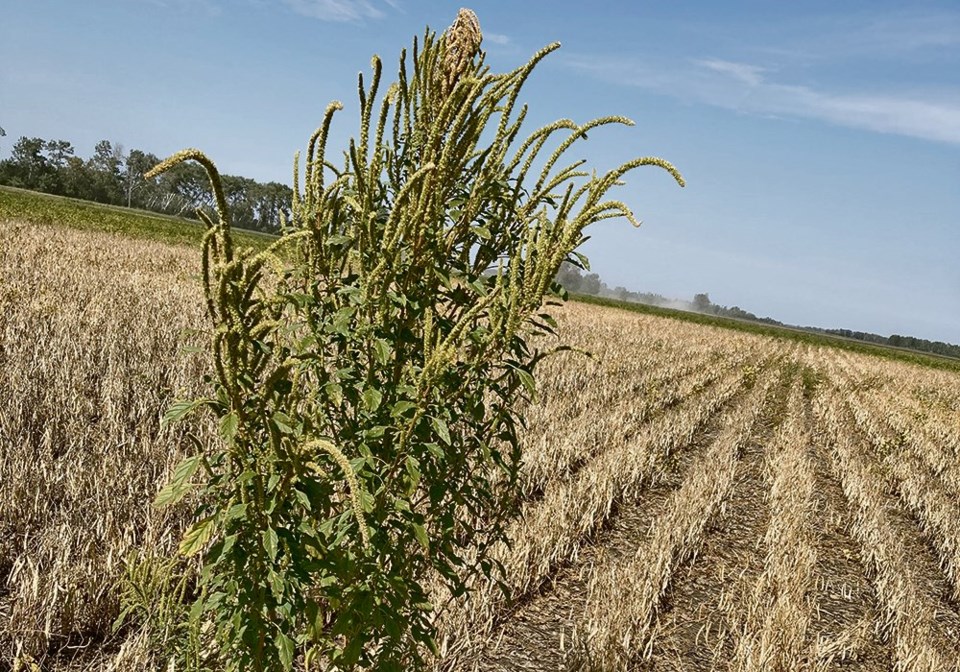DNA testing has confirmed the presence of Palmer amaranth in samples collected near Carman, Man., in the Rural Municipality of Dufferin.
Palmer is among three pigweed species on Manitoba’s tier one noxious weeds list, the others being tall waterhemp and smooth pigweed.
Kim Brown-Livingston, provincial weed specialist with Manitoba Agriculture and Resource Development, said Palmer amaranth is considered by most people to be the number one problematic weed in the U.S.
“Palmer amaranth and waterhemp are very aggressive weeds. They grow very rapidly and are prolific seed producers. They can produce up to a million seeds per plant on a big plant, but even routinely you’d be looking at a few hundred thousand to half a million seeds per plant,” Brown-Livingston said.
“They outcompete the crop very quickly and the Palmer and the waterhemp tend to be resistant to multiple herbicide groups and sometimes cross-resistant to several groups at a time.”
Waterhemp was first found in Manitoba in 2019 and there are areas in the U.S. where this pigweed has shown herbicide resistance to at least seven herbicide classes, including Group 2, 4, 5, 9, 14, 15 and 27. There are also waterhemp populations that exhibit resistances to several herbicide families.
Palmer amaranth is considered the most aggressive pigweed species, with populations displaying resistance to a Group 2, 3, 5, 9, and 27 herbicides in the U.S.
As with waterhemp, there are areas in the U.S. with Palmer populations that display resistance to multiple modes of action including Group 2 (ALS-inhibiting herbicides), and Group 9 (glyphosate). Some Palmer specimens have even developed resistance to three modes of action, Group 2, Group 5 (Photosystem II) and Group 27 (HPPD-inhibiting) herbicides.
More populations with multiple resistance are expected to evolve as the selection pressure from other herbicides increases.
Brown-Livingston said Palmer amaranth is especially problematic in row crops, because the wide rows provide space for the weeds to start before the crops canopy, and there are few crop herbicide options for many of the row crops.
“These weeds have really become a problem in the U.S. where they’re heavily weighted to corn and soybean in the rotation. In a lot of cases, they weren’t using anything but glyphosate in those rotations, so the weeds very quickly developed glyphosate resistance,” Brown-Livingston said.
If Palmer amaranth with glyphosate resistance gains a foothold in Canadian fields, tank mixing effective products with glyphosate will be necessary with glyphosate-resistant crops, including some soybeans, corn and canola varieties.
On infected fields, LibertyLink crops are still a good option because there is more flexibility in use rates and the number of applications of Group 10 herbicides that can be made to control the weed.
“In corn, we’re finding there’s a couple of Group 27 products that guys are using in crops that actually are working quite well in the pigweed. Unfortunately, resistance can develop fairly quickly if it’s used a lot. So that’s something that we have to watch,” Brown-Livingston said.
She said if Palmer amaranth with multiple resistance is present in crops sensitive to herbicides, it could leave farmers with no in-crop herbicide options.
“Palmer amaranth and the waterhemp really aren’t a problem in a good competitive cereal crop because those get established early and they close in the rows and they’re quite competitive,” Brown-Livingston said.
“There’s also different products that you’re using in wheat with a combination of a bunch of groups that are working quite well.”
Research out of the U.S. points to early-seeding dates, narrow-row spacing, high-plant populations, growing competitive crops, longer rotations, patch management and cover crops as effective at slowing the spread of Palmer amaranth and waterhemp.
Palmer amaranth and waterhemp are known to move with the help of wildlife including birds, contaminated seed and on equipment.
In crops where these large pigweeds can be seen when combining, Brown-Livingston suggests farmers cut and bag the weeds.
Combine cleanout is also an important tool to suppress the spread of these weeds, especially when using custom combiners or getting help from a neighbour.
When glyphosate-resistant waterhemp was first found in Ontario, researchers identified how a combine helped spread the weed.
“They tracked it to a custom combine in the area that had done one infested field and then had done surrounding fields,” Brown-Livingston said.
“I believe they found that glyphosate-resistant waterhemp in 14 more fields the next year.”
If a grower purchases a machine from a U.S. growing region where waterhemp or Palmer amaranth are present, it’s a good idea to thoroughly clean the machine before bringing it to the farm.
Brown-Livingston said it’s important to identify both waterhemp and Palmer amaranth early so growers can try to stop them before they get established.
“The seeds are tiny so it’s very easy for them to get moved around. We’re not surprised that we’re finding them. It was really just a matter of time and now we are in a race to make sure that they don’t become established,” she said.
“These are a couple of really bad ones.”

